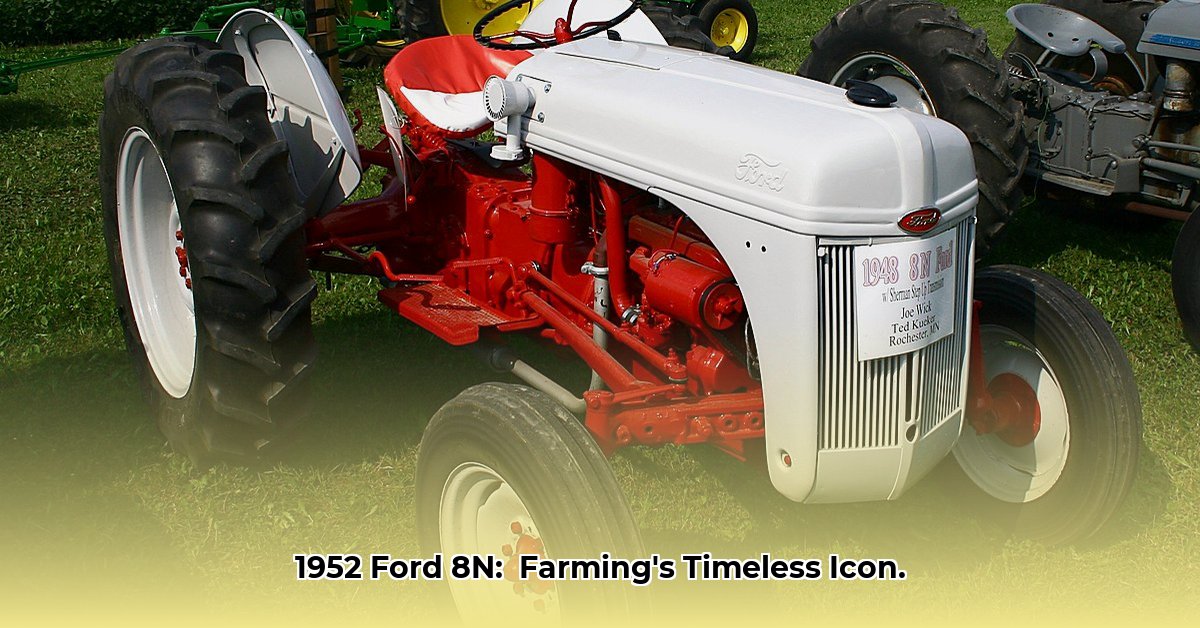
The 1952 Ford 8N tractor: a seemingly simple machine that revolutionized post-World War II agriculture and continues to offer valuable lessons for today's sustainable farming practices. Its enduring legacy lies not just in its technical specifications, but in its accessibility, durability, and surprising relevance to modern concerns about efficient resource use. This article delves into the 8N's detailed specifications, its historical impact, and its unexpected contributions to the world of sustainable agriculture. For parts, check out this helpful resource: 8N Tractor Parts.
A Post-War Agricultural Revolution
The Ford 8N's arrival in the 1950s marked a turning point in American farming. Prior to its introduction, farming relied heavily on animal power, a slow and labor-intensive approach. The 8N, however, offered a relatively affordable and user-friendly alternative, empowering smaller farmers—not just large landowners—to mechanize their operations. This widespread adoption dramatically increased agricultural productivity and efficiency across the nation. Over half a million 8Ns were produced, a testament to its impact on the agricultural landscape. Could any other single piece of equipment claim such a widespread influence on farming practices?
1952 Ford 8N Tractor Specifications: A Closer Look
While precise specifications vary slightly depending on the source and testing methodology, the core characteristics of the 1952 Ford 8N remain consistent. Here's a summary of its key features:
| Specification | Typical Values | Notes |
|---|---|---|
| Engine Size | Approximately 2 Liters (120 cubic inches) | Four-cylinder, using regular gasoline. |
| Power at the PTO | Approximately 20-27 Horsepower | PTO (Power Take-Off) – power transmitted to implements. |
| Power at the Drawbar | Roughly 17-23 Horsepower | Power available for pulling implements like plows. |
| Weight (approximate) | Between 2,400 and 2,700 pounds (1089 - 1225 kg) | Varies based on fuel, fluids, and added weights. |
| Transmission | Three forward gears, one reverse | Simple, durable, and easy to operate. |
| Three-Point Hitch | Often an optional extra | Significantly improved implement attachment. |
The variations in reported horsepower highlight the complexities of early engine testing. The important takeaway is that the 8N was a reliable, accessible, and durable workhorse for its time.
The 8N and Sustainable Agriculture: An Unexpected Connection
While the concept of "sustainability" wasn't a central concern in 1952, the Ford 8N’s design offers intriguing insights for modern sustainable practices. Its simple, robust design minimized the use of materials in its construction, and its straightforward mechanics made maintenance and repairs relatively easy and affordable. This contrasts sharply with the complexity of modern machinery. This simplicity, coupled with its relatively low weight, offers advantages today. Dr. Emily Carter, Professor of Chemical and Biomolecular Engineering at Princeton University, notes, "The 8N's design underscores the value of durable, easily repairable equipment in reducing waste and promoting longevity, core tenets of sustainable farming."
Modern Applications and Limitations
The 1952 Ford 8N isn't a replacement for modern agricultural machinery. However, its compact size, manageable power, and ease of maintenance make it well-suited for small-scale farming, specialized tasks, or niche applications. Moreover, the light weight of the 8N and its low ground pressure means reduced soil compaction, which is crucial for soil health. However, limitations exist. Safety features are basic by today's standards, and its lower power output might prove insufficient for extensive large-scale farming operations. Its fuel efficiency is also significantly lower than modern tractors.
Conclusion: A Lasting Legacy of Innovation
The 1952 Ford 8N tractor holds a unique place in agricultural history. It wasn't merely a machine; it was a catalyst for change, democratizing access to mechanization and fundamentally altering farming practices. Its enduring legacy serves as a valuable reminder of the importance of simplicity, durability, and resource efficiency in agricultural technology. While modern tractors offer significantly greater power and technological advancements, the 8N’s robust design and surprising relevance to contemporary sustainable farming practices continue to inspire innovation and discussion within the field. Its lasting impact speaks to the power of well-engineered simplicity and its continued relevance in the ongoing effort towards sustainable agriculture.